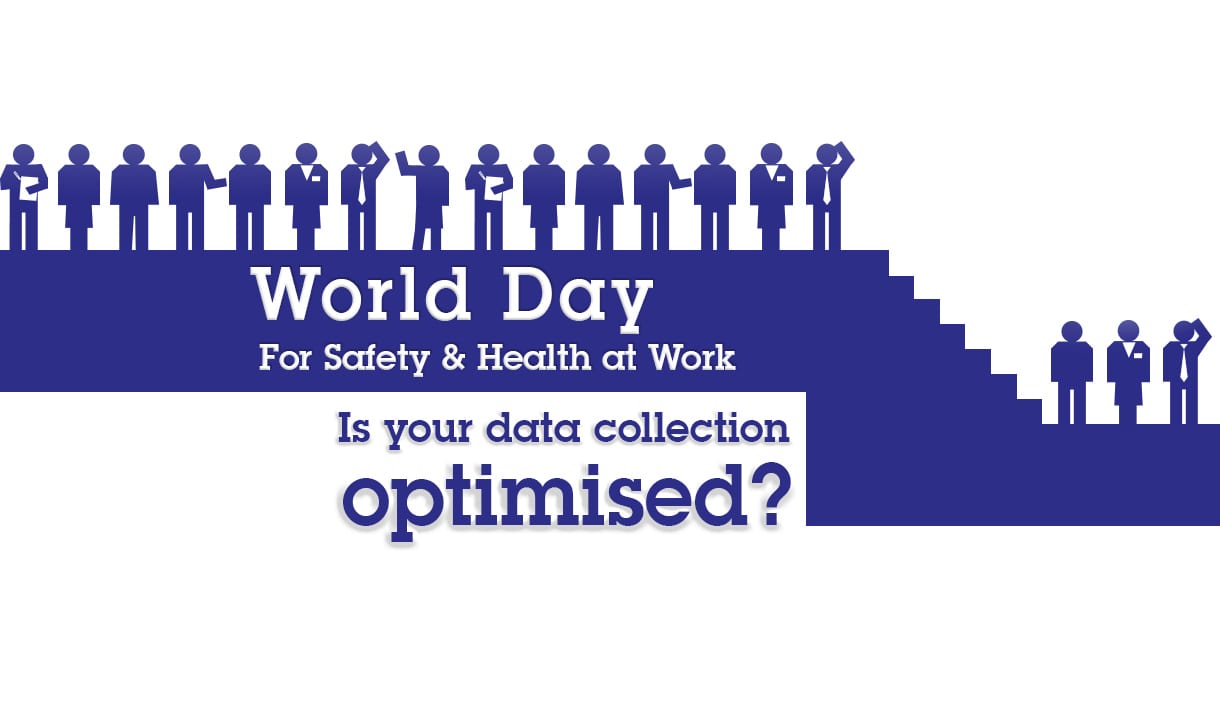World Day for Safety and Health at Work
Optimising the Collection of SHE Data
According to UN stats worldwide fatalities from work accidents and related diseases average at 6,300 people daily, in turn totalling 2.3 million per year in 317 million accidents.*1
These figures are almost unfathomable on paper but paint a particularly tragic picture on a personal scale; businesses suffer from prolonged absences or bad reputations while families may end up losing their loved one’s needlessly.
Established by the International Labour Organisation (ILO), each year the World Day for Safety and Health at Work draws attention to a key area of Health and Safety which warrants global intention. This year the focus is being placed upon ‘optimising the collection and use of Occupational Safety and Health (OSH) data’.
Typically, this is a mandate directed primarily at entire nations with large scale goals of eradicating poverty, disease and worker mistreatment. However, on a more immediate level, optimising the collection of SHE data is something we could all benefit from implementing in our respective workplaces.
Common failings of SHE statistic collection and analysis
Continual improvement should be the goal of any safety culture, but for this to happen accurate assessment on the effectiveness of existing measures is essential. Common failings of SHE statistic collection and analysis include:
- Taking low injury rates to signify good Health and Safety - While reduction and elimination injuries should be a part of any Health and Safety system’s goal, taking low injury rates at face value as a sign nothing is wrong can be a dangerous assumption. Chance will always play a small part in hazards and it’s important to consider that a lack of injuries may only reflect a smaller number of workers exposed rather than a flawless system.
- Placing emphasis on injury rates over severity – While the rate is important to report and analyse, failing to take severity into account in an assessment of Health and Safety can paint a very misleading picture. A few slight trips, scrapes or bruises may raise numbers but do not compare to the impact a life changing injury will have upon a workplace.
- Under-reporting – Most may be unwilling to lie directly about incidents, however casually disregarding the need to report them can be alarmingly common. This may occur out of general complacency, supported by a belief that the incident in question is minor or was a near miss. Alternatively, the disregard may arise from a dire to maintain a good SHE record. The issue with this attitude is that minor incidents often signify a far greater long-term problem; failing to react to it early may lead to a more serious accident in the future which should have been averted.
- Failing to account for health issues – While causes can be less obviously apparent, good workplace health is as essential as safety. If an aspect of workplace process or culture is negatively effecting employee health then it needs to be identified.
- Failing to appropriately categorise hazards – Over simplifying data and grouping things like physical occupational injuries with major hazards such as containment failure, toxins and fires may suggest an unfounded relationship between the two. This may prompt unsuitable or unnecessary action being taken.
In addition to the above low injury statistics can sometimes send the wrong message to companies; always keep in mind that they reflect the outcomes of Health and Safety failings and NOT the specific causes.
Along these lines taking low injury rates as an “all clear” to take no further action or ceases assessment can lead to complacency, which in turn opens the door for a probable disaster.
Health and Safety Performance Measurement
According to HSE guidelines*2 Health and Safety performance measurement should utilise a balanced approach comprised of the following:
- Monitoring input – Tracking the scale, type and location of hazards created by workplace activities to measure the hazard burden.
- Active monitoring of process – This includes monitoring how adequate health and safety management systems are and how well they are implemented into work processes. This should also include activities designed to promote a positive SHE culture within the workplace.
- Outcomes – Reactively monitoring adverse outcomes from minor incidents up to serious accidents, injuries and bouts of ill health.
Hazard Burden
Hazards arising because of workplace activities are virtually inevitable. Assessing the scale, nature and location of these should allow you to identify the associated risks and act to control them.
The assessment of this hazard burden should address the following questions:
- Which hazards are associated with the activity in question?
- What is the severity for these hazards? Are they ‘high’ or ‘low’?
- Does the nature and severity of the hazards vary in different areas of the workplace?
- Are there any hazards in danger of becoming more severe over time?
- Are existing control measures eliminating or reducing hazards? Is the reduction adequate or does it require further changes?
- Are planned business changes likely to change the nature of severity of identified hazards?
Tip of the Iceberg
Basic SHE data often indicates part of a serious problem in the workplace, however the suggestions covered here are essentially only the tip of the iceberg.
Ultimately, effective collection and use of Health and Safety requires professional expertise and qualification to meet legislative standards and guarantee an informed set of management systems. A NEBOSH Certificate equips managers with the knowledge to make sense of data and counter with appropriate systems. Additionally, specialist certificates are also available covering a range of specific SHE careers including Fire, Well-Being, Environmental and Construction safety.
By recognising our failings, supporting our actions with the appropriate know-how and remaining vigilant to new risks we can all do our part to get global injury statistics down by the World Day for Safety and Health at Work.
Owen Roach
*1https://www.un.org/en/events/safeworkday/
*2https://www.hse.gov.uk/opsunit/perfmeas.pdf
Published on 27/04/2017








Leave a Reply
Want to join the discussion?Feel free to contribute!